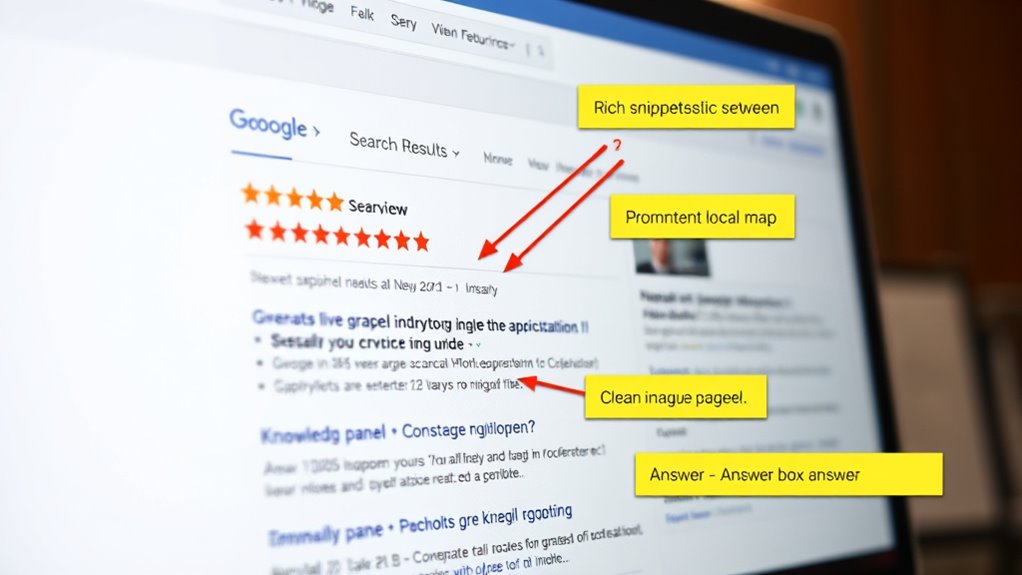A SERP feature is an element on a search results page that provides extra information beyond just links, like images, videos, local maps, or answered questions. These features help you find what you need faster and make your browsing more interactive. They highlight specific content types and answer common questions right on the results page. If you keep exploring, you’ll see how these features can improve your search experience and help you get answers swiftly.
Key Takeaways
- SERP features are elements beyond traditional links, like snippets, images, and videos, enhancing search results.
- They provide quick answers and relevant information, reducing the need to click multiple links.
- Common types include featured snippets, knowledge panels, local packs, and “People Also Ask” sections.
- These features are often personalized and marked with icons to distinguish them from regular results.
- Optimizing for SERP features can improve visibility and help users find information faster.

Search Engine Results Pages (SERPs) have evolved far beyond simple blue links, offering a variety of features designed to enhance your search experience. These features aim to provide quick access to the information you need, often displaying more than just links to websites. Instead, they include rich snippets, images, videos, and interactive elements that help you find answers faster. When you type a query, you might notice that some results stand out because of these added features. Understanding what these features are and how they work can help you better interpret the search results and make smarter decisions about which links to click.
SERP features enhance search results with rich snippets, images, videos, and interactive elements for faster, smarter online browsing.
A SERP feature is any element on a search results page that goes beyond the traditional organic listings. These features are designed to highlight specific types of content or answer common questions directly on the results page. For example, featured snippets display a concise answer extracted from a website, often at the top of the page, so you can get your answer without clicking through. Knowledge panels appear on the right side of the results page, providing detailed information about entities like people, places, or organizations. Local packs show nearby businesses, maps, and reviews, making it easier to find local services. Image carousels or video sections display visual content related to your query, giving you a richer browsing experience.
You might also see search features like “People Also Ask,” which presents related questions with expandable answers, helping you explore different angles of your search. There are also shopping carousels for e-commerce queries, displaying products with prices and reviews directly on the results page. These features are typically marked with icons or labels to distinguish them from standard links, and they are often personalized based on your location, search history, or device type. Recognizing these features allows you to quickly identify the most relevant or useful information, saving you time and effort. Additionally, understanding SERP features can improve your ability to optimize content for better visibility in search results.
Ultimately, SERP features are tools built to improve your search journey by presenting diverse content formats in an easily accessible manner. They’re designed to answer your questions faster, help you explore related topics, and even make local or shopping decisions more straightforward. As a user, understanding these features helps you navigate search results more effectively, ensuring you can find the right information with less hassle. Whether it’s a quick answer, a visual guide, or local information, SERP features are there to serve your needs and streamline your online research process.
Frequently Asked Questions
How Do SERP Features Impact Organic Search Rankings?
SERP features can influence your organic search rankings by increasing visibility and click-through rates. When your content appears in rich snippets, knowledge panels, or other features, it attracts more attention, potentially boosting your position in search results. However, they don’t directly improve rankings; instead, they enhance your chances of being noticed and clicked, which can indirectly lead to better rankings over time through increased engagement.
Can I Control Which SERP Features Appear for My Keywords?
Did you know that over 80% of search results include at least one SERP feature? You can’t directly control which features appear for your keywords, but you can influence their likelihood. Optimizing your content for featured snippets, local packs, and images increases your chances. Focus on creating clear, high-quality content, use structured data, and target long-tail keywords to improve your visibility in these valuable SERP elements.
Are SERP Features the Same Across All Search Engines?
No, SERP features aren’t the same across all search engines. Google, Bing, and others display different features based on their algorithms and user focus. For example, Google often shows rich snippets, knowledge panels, and local packs, while Bing might emphasize images and videos more. You should optimize your content for each platform to maximize visibility, as each search engine offers unique opportunities to attract traffic.
How Often Do SERP Features Change or Update?
SERP features update frequently, sometimes daily, reflecting the ever-changing digital landscape. Just like news updates or trending topics, these features evolve as search engines refine their algorithms and add new tools. You might see a new featured snippet, local pack, or knowledge panel appear unexpectedly. Staying current means regularly monitoring your search results and adjusting your strategies, because what’s prominent today could be replaced tomorrow.
Do Paid Ads Influence the Appearance of SERP Features?
Yes, paid ads can influence the appearance of SERP features. When you run paid ads, they often appear at the top or bottom of search results, which can push organic features further down. Sometimes, ads trigger specific SERP features like shopping boxes or local packs. This means your paid content can impact where and how other features display, shaping the overall search experience for users.
Conclusion
Now that you know what SERP features are and how they can impact your search results, aren’t you enthusiastic to optimize your content to stand out? These features can boost your visibility and drive more traffic to your site if you understand how to leverage them. So, why not start exploring these opportunities today? After all, in the ever-changing world of search, staying ahead means knowing what’s available and how to use it to your advantage.









